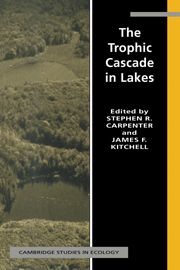Book contents
- Frontmatter
- Contents
- Contributors
- Preface
- 1 Cascading trophic interactions
- 2 Experimental lakes, manipulations and measurements
- 3 Statistical analysis of the ecosystem experiments
- 4 The fish populations
- 5 Fish behavioral and community responses to manipulation
- 6 Roles of fish predation: piscivory and planktivory
- 7 Dynamics of the phantom midge: implications for zooplankton
- 8 Zooplankton community dynamics
- 9 Effects of predators and food supply on diel vertical migration of Daphnia
- 10 Zooplankton biomass and body size
- 11 Phytoplankton community dynamics
- 12 Metalimnetic phytoplankton dynamics
- 13 Primary production and its interactions with nutrients and light transmission
- 14 Heterotrophic microbial processes
- 15 Annual fossil records of food-web manipulation
- 16 Simulation models of the trophic cascade: predictions and evaluations
- 17 Synthesis and new directions
- References
- Index
8 - Zooplankton community dynamics
Published online by Cambridge University Press: 06 August 2010
- Frontmatter
- Contents
- Contributors
- Preface
- 1 Cascading trophic interactions
- 2 Experimental lakes, manipulations and measurements
- 3 Statistical analysis of the ecosystem experiments
- 4 The fish populations
- 5 Fish behavioral and community responses to manipulation
- 6 Roles of fish predation: piscivory and planktivory
- 7 Dynamics of the phantom midge: implications for zooplankton
- 8 Zooplankton community dynamics
- 9 Effects of predators and food supply on diel vertical migration of Daphnia
- 10 Zooplankton biomass and body size
- 11 Phytoplankton community dynamics
- 12 Metalimnetic phytoplankton dynamics
- 13 Primary production and its interactions with nutrients and light transmission
- 14 Heterotrophic microbial processes
- 15 Annual fossil records of food-web manipulation
- 16 Simulation models of the trophic cascade: predictions and evaluations
- 17 Synthesis and new directions
- References
- Index
Summary
Introduction
Whole-lake manipulations of the fish assemblages in Peter and Tuesday Lakes provided an excellent opportunity to ask how vertebrate and invertebrate predators affect zooplankton communities. A central element of the cascade hypothesis is the regulation of large herbivores by visually feeding planktivores. In the light of the prominent position that large herbivores can occupy in zooplankton communities, repercussions in populations of less conspicuous taxa are expected (Lewis, 1979; Zaret, 1980; Kerfoot & Sih, 1987). These include compensatory shifts in the dominant species and increases in previously rare species.
Planktivory by fishes and invertebrates (such as Chaoborus) has both direct and indirect effects on zooplankton populations (Zaret, 1980; Neill, 1981; Vanni, 1986). Fish predation can constrain the maximum adult body size of prey, while invertebrate predation can restrict the minimum size. Either can interact with effects of food limitation to alter zooplankton populations (Hall et al., 1976). At the community level, however, the significance of predation is less clear. Changes in density alone may not be sufficient to alter competitive exclusion, diversity, or their consequences for the community (Thorp, 1986). Interpretations of zooplankton community structure must consider competitive interactions among species, especially among the dominant herbivores (Lynch, 1979).
In this chapter, we focus on the changes in the zooplankton communities of Peter and Tuesday Lakes as a result of fish manipulations and contrast them to the natural variation exhibited by Paul Lake.
- Type
- Chapter
- Information
- The Trophic Cascade in Lakes , pp. 116 - 152Publisher: Cambridge University PressPrint publication year: 1993
- 6
- Cited by



